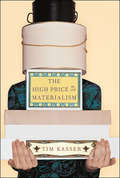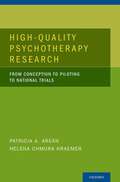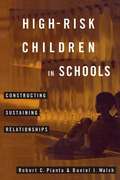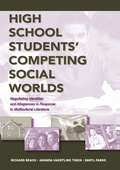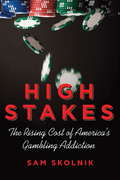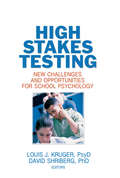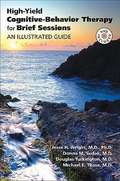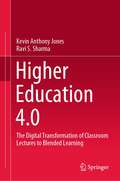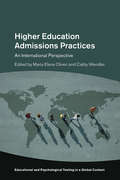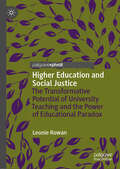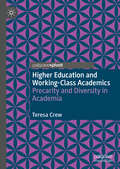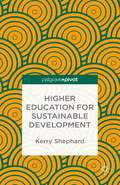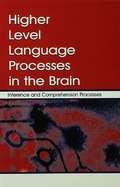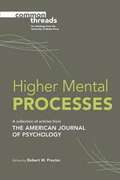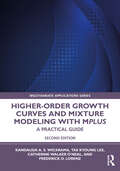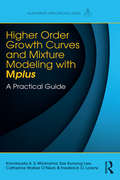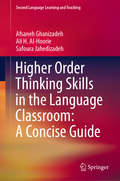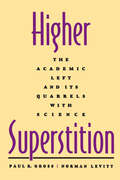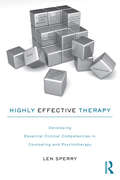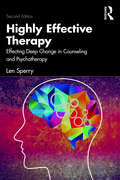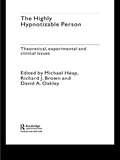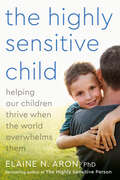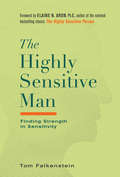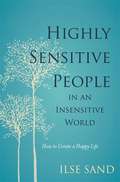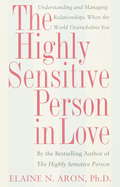- Table View
- List View
The High Price of Materialism
by Tim KasserA study of how materialism and consumerism undermine our quality of life.In The High Price of Materialism, Tim Kasser offers a scientific explanation of how our contemporary culture of consumerism and materialism affects our everyday happiness and psychological health. Other writers have shown that once we have sufficient food, shelter, and clothing, further material gains do little to improve our well-being. Kasser goes beyond these findings to investigate how people's materialistic desires relate to their well-being. He shows that people whose values center on the accumulation of wealth or material possessions face a greater risk of unhappiness, including anxiety, depression, low self-esteem, and problems with intimacy—regardless of age, income, or culture.Drawing on a decade's worth of empirical data, Kasser examines what happens when we organize our lives around materialistic pursuits. He looks at the effects on our internal experience and interpersonal relationships, as well as on our communities and the world at large. He shows that materialistic values actually undermine our well-being, as they perpetuate feelings of insecurity, weaken the ties that bind us, and make us feel less free. Kasser not only defines the problem but proposes ways we can change ourselves, our families, and society to become less materialistic.
High-Quality Psychotherapy Research: From Conception to Piloting to National Trial
by Patricia A. Arean Helena Chmura Kraemerlthough psychotherapy research shares many of the same methodological issues that pharmacology trials do, psychotherapy research poses unique challenges, including the difficulty (if not near impossibility) of keeping participants blind to treatment assignment, the need for a replicable manual and therapist training procedure, the importance of outside observation of therapy quality ratings, and the problems researchers face in measuring the active ingredients of psychotherapy. High-Quality Psychotherapy Research is for all psychotherapy investigators who wish to learn state-of-the-art psychotherapy research methods. Organized developmentally, the book explains the conceptualization of the trial, discusses the pilot study and the large scale study, and concludes with instructions for designing a multi-site trial. Topics specific to psychotherapy research are examined in detail, including innovations in data analysis, how to conduct multi-site psychotherapy trials, mediation of treatment outcomes, the transportability of evidence-based behavioral interventions in community practice, training community providers to be study therapists, and recruiting hard-to-reach populations. High-Quality Psychotherapy Research is an informative, practical book appropriate for a broad range of readers, from junior investigators developing their first study idea to seasoned investigators who wish to take their research to a larger-scale level.
High-Risk Children In Schools: Constructing Sustaining Relationships
by Robert Pianta Daniel WalshHigh Risk Children in Schools offers a way for psychologists and educators to see and talk about the growing population of "at-risk" children--those likely to fail at formal schooling--while helping to redefine the relationship between schools and families. Using systems theory and developmental psychology, the authors present a new framework for the study and education of children who are at-risk. This framework--the Contextual Systems Model--creates a dialogue between the child and schooling through which meaning, goals, and experiences are shared and accepted.
High School Students' Competing Social Worlds: Negotiating Identities and Allegiances in Response to Multicultural Literature
by Richard Beach Amanda Haertling Thein Daryl L. ParksThis book examines how working-class high school students’ identity construction is continually mediated by discourses and cultural practices operating in their classroom, school, family, sports, community, and workplace worlds. Specifically, it addresses how responding to cultural differences portrayed in multicultural literature can serve to challenge adolescents’ allegiances to status quo discourses and cultural models, and how teachers not only can rouse students to clarify and change their value stances related to race, class, and gender, but also provide support for and validation of students’ self-interrogation. Highlighting the influence of sociocultural forces, the book contributes to understanding the role of institutions in shaping adolescents’ lives, and identifies needs that must be addressed to improve those institutions. Current theory and research on critical discourse analysis, cultural models theory, and identity construction is meshed with specific applications of that theory and research to case-study profiles and analysis of classroom discussions. The instructional strategies described enable pre-service and in-service teachers to develop their own literature curriculum and instructional methods.
High Stakes: The Rising Cost of America's Gambling Addiction
by Sam SkolnikAmerica is becoming hooked on gambling. From the millions of dens and dorm rooms lit by online poker games to the neighborhoods transformed by new casinos and slot machine parlors, legalized gambling has become an integral part of our lives. With a singular blend of investigative journalism and poignant narratives of gambling addiction, award-winning journalist Sam Skolnik provides an in-depth exploration of the consequences of this national phenomenon. The result is High Stakes, an unflinching look at the explosive growth of legalized gambling in our country, the concurrent rise of addicted gamblers, and what it all means. Thirty-five years ago, casinos were legal in just one state, Nevada. Today, legalized gambling has morphed into a $92 billion industry established in all but two states. As elected officials are urging voters to expand gambling's reach, the industry's supporters and their equally impassioned detractors are squaring off in prolonged state-by-state battles. Millions of Americans are being asked to decide: Are the benefits worth the costs? Industry officials and their political allies assert that gambling is an effective way to raise revenue and create jobs. But these rewards come at a steep price. Fast-rising numbers of addicted gamblers are causing higher indebtedness and bankruptcy rates, as well as increased divorces, suicides, and gambling-related crime. Skolnik shows how the gambling industry is targeting Asian Americans--and why this population, more than any other ethnic group, is likely to develop gambling problems. He also illustrates how gambling has helped turn Las Vegas into America's most dysfunctional community, and how the upsurge of poker and Internet gambling has created a new generation of gambling junkies. In High Stakes, we meet politicians eager to promote legalized gambling as an economic cure-all, scientists wrestling with the meaning of gambling addiction, and ensnared players so caught up in the chase that they've lost their livelihoods and their minds. Throughout it all, Skolnik--an avid poker player--never loses sight of the human side of these struggles.From the Hardcover edition.
High Stakes Testing: New Challenges and Opportunities for School Psychology
by Louis J. Kruger David ShribergMeet the challenges of high stakes testing in the practice of school psychology School psychologists can be a positive influence on how students, teachers, parents, schools, and communities cope with the challenges and opportunities associated with high stakes testing. Unfortunately, there has been a significant lack of literature to guide school psychologists and related school-based practitioners on this topic. High Stakes Testing: New Challenges and Opportunities for School Psychology is a timely groundbreaking book that provides useful and thought-provoking information to help psychologists meet the challenges of high stakes testing and create new roles for themselves in helping children succeed. This book discusses practical ways to help provide academic support to facilitate student success on high stakes tests, reduce the impact of stress associated with high stakes testing, assess the data from the tests to improve programs, and take a leadership role in the appropriate use of the tests. The No Child Left Behind Act of 2001(NCLB) and its accountability provisions has helped create and sustain a climate where student performance on state-created achievement tests often has high stakes implications for students, families, and schools. High Stakes Testing: New Challenges and Opportunities for School Psychology provides important background information about high stakes testing, including the legal, historical, and political context of high stakes testing, pertinent psychometrics, and a review of research on academic and non-academic outcomes as it relates to high stakes testing. Using this information as a foundation, the book then identifies new roles and opportunities for school psychologists with respect to high stakes testing. This book is comprehensively referenced. Topics in High Stakes Testing: New Challenges and Opportunities for School Psychology include: advocating for the appropriate use of state-wide assessments the influence of item response theory (IRT) on the development of high stakes tests whether the accountability system of NCLB is truly improving student&’s learning the impact of high stakes tests on classroom instruction and student motivation strategies for helping students succeed on high stakes tests available resources to cope with the stress of high stakes testing and more High Stakes Testing: New Challenges and Opportunities for School Psychology is a thought-provoking, horizon-expanding resource for school psychologists, public school educators, administrators, school counselors, curriculum coordinators, and special education teachers involved in organizing, administering, and preparing students to take high stakes tests.
High-Yield Cognitive-Behavior Therapy for Brief Sessions: An Illustrated Guide
by Jesse H. Wright Douglas Turkington Donna M. Sudak Michael E. ThaseHigh-Yield Cognitive-Behavior Therapy for Brief Sessions: An Illustrated Guide breaks entirely new ground in explaining how to weave together the powerful tools of CBT with pharmacotherapy in sessions shorter than the traditional "50-minute hour. " Written for psychiatrists, therapists, and other clinicians, the book details ways to enrich brief sessions with practical CBT interventions that work to relieve symptoms and promote wellness. An engaging and instructive resource of video illustrations included with the book demonstrates how to successfully implement brief CBT sessions for some of the most common and important problems seen in clinical practice -- depression, anxiety, psychotic symptoms, suicidality, sleep disturbances, substance abuse, and coping with physical health issues. Written by practicing clinicians with extensive experience in combining CBT and pharmacotherapy, this volume builds on the constructs and techniques described in the authors' earlier best-selling illustrated guides, Learning Cognitive-Behavior Therapy and Cognitive-Behavior Therapy for Severe Mental Illness. The authors describe in detail the general features of CBT that can be applied in less time than the 50-minute hour #149; The therapist and patient function as an investigative team; the power of this collaborative empiricism can be evident in even the shortest of clinical encounters. #149; Clinicians teach patients how to rapidly set agendas, focus on specific problems, pace sessions, and give and receive feedback on progress; this structuring approach is especially well-suited to brief sessions. #149; A basic tenet of CBT, psychoeducation can effectively be delivered in sessions shorter than 45-60 minutes and, in fact, may become a more dominant aspect of treatment during briefer time frames. #149; Patients can learn practical, high-yield methods for decreasing symptoms fairly quickly, making these methods highly suitable for application in shorter sessions. #149; Homework extends learning beyond the confines of the session and encourages self-help in the treatment process, effectively increasing the value of shortened clinician-patient time. When sessions are brief, clinicians must be able to generate succinct and targeted formulations that include key pieces of information that allow for full understanding of the patient, while honing in on specific problems where positive results can be collaboratively pursued. This book, with its video illustrations and learning exercises, was designed to help readers achieve incisive formulations while they sharpen their basic CBT techniques and successfully apply this knowledge in the stimulating and rewarding domain of brief sessions. A must-read for working clinicians as well as trainees, this book offers pragmatic solutions for the challenge of providing effective psychotherapy in brief treatment sessions.
Higher Education 4.0: The Digital Transformation of Classroom Lectures to Blended Learning
by Kevin Anthony Jones Sharma RavishankarThis book chronicles a 10-year introduction of blended learning into the delivery at a leading technological university, with a longstanding tradition of technology-enabled teaching and learning, and state-of-the-art infrastructure. Hence, both teachers and students were familiar with the idea of online courses. Despite this, the longitudinal experiment did not proceed as expected. Though few technical problems, it required behavioural changes from teachers and learners, thus unearthing a host of socio-technical issues, challenges, and conundrums. With the undercurrent of design ideals such as “tech for good”, any industrial sector must examine whether digital platforms are credible substitutes or at best complementary. In this era of Industry 4.0, higher education, like any other industry, should not be about the creative destruction of what we value in universities, but their digital transformation. The book concludes with an agenda for large, repeatable Randomised Controlled Trials (RCTs) to validate digital platforms that could fulfil the aspirations of the key stakeholder groups – students, faculty, and regulators as well as delving into the role of Massive Open Online Courses (MOOCs) as surrogates for “fees-free” higher education and whether the design of such a HiEd 4.0 platform is even a credible proposition. Specifically, the book examines the data-driven evidence within a design-based research methodology to present outcomes of two alternative instructional designs evaluated – traditional lecturing and blended learning. Based on the research findings and statistical analysis, it concludes that the inexorable shift to online delivery of education must be guided by informed educational management and innovation.
Higher Education Admissions Practices: An International Perspective (Educational and Psychological Testing in a Global Context)
by María Elena Oliveri Cathy WendlerThis book provides a path for resolving challenges related to access, diversity, equity, and other issues facing higher education admissions. It illuminates current higher education admissions practices in a global context, highlighting common obstacles. The chapters outline decision-making models used in college admissions, details those assessments commonly employed in admissions, and provides innovative perspectives on the future of admissions. The book's multidisciplinary approach defines much-needed changes in admissions brought about by shifts in the makeup of student populations and in higher education itself. Rationales for moving away from traditional assessments used in admissions and expanding the criteria used to ensure a student's academic success are discussed. Readers will come away with an understanding of the current issues, philosophies, and historical circumstances facing higher education admissions across the globe and will be equipped to contemplate and react to future possibilities and opportunities.
Higher Education and Social Justice: The Transformative Potential of University Teaching and the Power of Educational Paradox
by Leonie RowanThis book demonstrates how the pedagogical decision making of university academics can be shaped by engagement with an educational philosophy known as “relationship-centred education”. Beginning with critical analysis of concepts such as student engagement, student satisfaction, and student-centred learning, the author goes on to investigate how literature relating to social justice challenges educators to consider these terms in particular ways. From this basis, the book explores the factors featuring in inclusive, respectful, diverse and student-centred environments. In analysing these factors, the author illuminates the perspectives of university teachers who struggle with the unique challenges of working in the academy; including an increasingly broad set of employment demands and narrower criteria for determining ‘impact’, all while retaining focus on the transformative potential of higher education. This book will be of interest to students and scholars of transformative learning, as well as social justice within higher education.
Higher Education and Working-Class Academics: Precarity and Diversity in Academia
by Teresa CrewThis book examines how a working-class habitus interacts with the elite culture of academia in higher education. Drawing on extensive qualitative data and informed by the work of Pierre Bourdieu, the author presents new ways of examining impostor syndrome, alienation and microaggressions: all common to the working-class experience of academia. The book demonstrates that the term ‘working-class academic’ is not homogenous, and instead illuminates the entanglements of class and academia. Through an examination of such intersections as ethnicity, gender, dis/ability, and place, the author demonstrates the complexity of class and academia in the UK and asks how we can move forward so working-class academics can support both each other and students from all backgrounds.
Higher Education for Sustainable Development
by Kerry ShephardThis book asks how higher education should approach the task of educating for sustainability and then sets to answering it. It provides a guide for those who advocate for sustainability and for those who do not and makes a point of emphasising that all in higher education have the capacity and willingness to contribute in some way. The challenge is to find an approach that unifies the efforts of higher education teachers towards sustainability objectives, rather than dividing them. People at universities across the world were consulted and a grounded theory was devised. This encourages all university teachers to teach what they want to teach openly and honestly, about sustainability or not; but on the way to ensure that their students develop the critical skills that will enable them to fully understand what is being taught and what they are learning.
Higher Level Language Processes in the Brain: Inference and Comprehension Processes
by Franz Schmalhofer Charles A. PerfettiHigher Level Language Processes in the Brain is a groundbreaking book that explains how behavior research, computational models, and brain imaging results can be unified in the study of human comprehension. The volume illustrates the most comprehensive and newest findings on the topic. Each section of the book nurtures the theoretical and practical
Higher Mental Processes
by Robert W ProctorIn this new book, Robert W. Proctor curates a collection of celebrated and seminal articles from the past 125 years of the American Journal of Psychology . The debut volume in the University of Illinois Press TMs Common Threads series, Higher Mental Processes reprints a suite of ten articles on processes of higher-order thinking. Proctor, current editor of the AJP , begins the volume with a special introduction that provides historical and scientific context for the contributions. Contributors: P. Baratta, M. H. Birnbaum, M. E. Bulbrook, L. S. Buyer, R. A. Carlson, S. N. F. Chant, A. A. Cleveland, T. D. Cutsforth, R. L. Dominowski, E. Galanter, P. N. Johnson-Laird, M. G. Preston, Robert W. Proctor, and J. Tagart.
Higher-Order Growth Curves and Mixture Modeling with Mplus: A Practical Guide (Multivariate Applications Series)
by Kandauda A.S. Wickrama Tae Kyoung Lee Catherine Walker O’Neal Frederick O. LorenzThis practical introduction to second-order and growth mixture models using Mplus introduces simple and complex techniques through incremental steps. The authors extend latent growth curves to second-order growth curve and mixture models and then combine the two using normal and non-normal (e.g., categorical) data. To maximize understanding, each model is presented with basic structural equations, figures with associated syntax that highlight what the statistics mean, Mplus applications, and an interpretation of results. Examples from a variety of disciplines demonstrate the use of the models and exercises allow readers to test their understanding of the techniques. A comprehensive introduction to confirmatory factor analysis, latent growth curve modeling, and growth mixture modeling is provided so the book can be used by readers of various skill levels. The book’s datasets are available on the web. New to this edition: * Two new chapters providing a stepwise introduction and practical guide to the application of second-order growth curves and mixture models with categorical outcomes using the Mplus program. Complete with exercises, answer keys, and downloadable data files. * Updated illustrative examples using Mplus 8.0 include conceptual figures, Mplus program syntax, and an interpretation of results to show readers how to carry out the analyses with actual data. This text is ideal for use in graduate courses or workshops on advanced structural equation, multilevel, longitudinal or latent variable modeling, latent growth curve and mixture modeling, factor analysis, multivariate statistics, or advanced quantitative techniques (methods) across the social and behavioral sciences.
Higher-Order Growth Curves and Mixture Modeling with Mplus: A Practical Guide (Multivariate Applications Series)
by Kandauda K.A.S. Wickrama Tae Kyoung Lee Catherine Walker O’Neal Frederick O. LorenzThis practical introduction to second-order and growth mixture models using Mplus introduces simple and complex techniques through incremental steps. The authors extend latent growth curves to second-order growth curve and mixture models and then combine the two. To maximize understanding, each model is presented with basic structural equations, figures with associated syntax that highlight what the statistics mean, Mplus applications, and an interpretation of results. Examples from a variety of disciplines demonstrate the use of the models and exercises allow readers to test their understanding of the techniques. A comprehensive introduction to confirmatory factor analysis, latent growth curve modeling, and growth mixture modeling is provided so the book can be used by readers of various skill levels. The book’s datasets are available on the web. Highlights include: -Illustrative examples using Mplus 7.4 include conceptual figures, Mplus program syntax, and an interpretation of results to show readers how to carry out the analyses with actual data. -Exercises with an answer key allow readers to practice the skills they learn. -Applications to a variety of disciplines appeal to those in the behavioral, social, political, educational, occupational, business, and health sciences. -Data files for all the illustrative examples and exercises at www.routledge.com/9781138925151 allow readers to test their understanding of the concepts. -Point to Remember boxes aid in reader comprehension or provide in-depth discussions of key statistical or theoretical concepts. Part 1 introduces basic structural equation modeling (SEM) as well as first- and second-order growth curve modeling. The book opens with the basic concepts from SEM, possible extensions of conventional growth curve models, and the data and measures used throughout the book. The subsequent chapters in part 1 explain the extensions. Chapter 2 introduces conventional modeling of multidimensional panel data, including confirmatory factor analysis (CFA) and growth curve modeling, and its limitations. The logical and theoretical extension of a CFA to a second-order growth curve, known as curve-of-factors model (CFM), are explained in Chapter 3. Chapter 4 illustrates the estimation and interpretation of unconditional and conditional CFMs. Chapter 5 presents the logical and theoretical extension of a parallel process model to a second-order growth curve, known as factor-of-curves model (FCM). Chapter 6 illustrates the estimation and interpretation of unconditional and conditional FCMs. Part 2 reviews growth mixture modeling including unconditional growth mixture modeling (Ch. 7) and conditional growth mixture models (Ch. 8). How to extend second-order growth curves (curve-of-factors and factor-of-curves models) to growth mixture models is highlighted in Chapter 9. Ideal as a supplement for use in graduate courses on (advanced) structural equation, multilevel, longitudinal, or latent variable modeling, latent growth curve and mixture modeling, factor analysis, multivariate statistics, or advanced quantitative techniques (methods) taught in psychology, human development and family studies, business, education, health, and social sciences, this book’s practical approach also appeals to researchers. Prerequisites include a basic knowledge of intermediate statistics and structural equation modeling.
Higher Order Thinking Skills in the Language Classroom: A Concise Guide (Second Language Learning and Teaching)
by Afsaneh Ghanizadeh Ali H. Al-Hoorie Safoura JahedizadehIn this book, we try to provide a practical, down-to-earth guide for those who are involved in language learning and teaching. We hope that this book will be a useful reading for those who would like to incorporate higher-order thinking skills (HOTS)-enhancing techniques in their teaching practice. We set out from the position that, although it is hardly doubtful that it is at the heart of education, critical thinking is in reality often not given its due attention in pedagogy, particularly in language education. This book offers readers some practical advice on how to implement HOTS in their own practice. It has been written to take the reader through each technique with the ultimate goal of promoting HOTS step-by-step. In the introductory chapter, we present an overview of the theory behind HOTS, its definition, its relation to Bloom’s Taxonomy, its two dimensions (critical thinking and reflective thinking), and the ideas of some influential thinkers in this area. The subsequent chapters present six HOTS-enhancing techniques that classroom teachers can draw from, namely graphic organizers, critical discourse analysis, argumentation, emotion regulation and emotional intelligence enhancing techniques, reflective journals, and mindfulness-based strategies. As the book draws on a wide-ranging review of literature with exercises for direct use with language learners, we hope that this provides both theoretical and practical support for the teaching process to help language learners become effective critical thinkers. The compilation of the ideas in this book took us a long time, over a decade. Something that takes such a long time requires much engagement and life experience; so did this book.
Higher Superstition: The Academic Left and Its Quarrels with Science
by Paul R. Gross Norman LevittThe widely acclaimed response to the postmodernists attacks on science, with a new afterword.With the emergence of "cultural studies" and the blurring of once-clear academic boundaries, scholars are turning to subjects far outside their traditional disciplines and areas of expertise. In Higher Superstition scientists Paul Gross and Norman Levitt raise serious questions about the growing criticism of science by humanists and social scientists on the "academic left." This edition of Higher Superstition includes a new afterword by the authors.
Highly Effective Therapy: Developing Essential Clinical Competencies in Counseling and Psychotherapy
by Len SperryMental health professionals and accrediting bodies have steadily been embracing competency-focused learning and clinical practice. In contrast to a skill, a competency is a level of sufficiency evaluated against an external standard. Learning to be clinically competent involves considerably more than the current emphasis on skill and micro skill training. While there are now a small number of books that describe the various clinical competencies of counseling and psychotherapy, none of these books focus on how to learn them. Highly Effective Therapy emphasizes the process of learning these essential competencies. It illustrates them in action with evidence-based treatment protocols and clinical simulations to foster learning and competency. Highly Effective Therapy is a hands-on book that promotes learning of the 20 competencies needed for effective and successful clinical practice.
Highly Effective Therapy: Effecting Deep Change in Counseling and Psychotherapy
by Len SperryTrainees and practitioners need a trusted resource for mastering the essential skills and competencies necessary for effecting deep, lasting change in their clients. This second edition of Highly Effective Therapy: Effecting Deep Change in Counseling and Psychotherapy is that resource. It updates the 20 essential skill sets and clinical competencies needed for a highly effective and successful clinical practice. It illustrates them in action with evidence-based treatment protocols and clinical simulations to foster learning and competency. Sperry emphasizes the process of easily learning these research-based clinical competencies with added case examples and session transcriptions. New to this edition is trauma assessment, protective factors, and ultra-brief cognitive behavioral interventions. This second edition is written in an accessible format and is essential for practitioners, trainees, and instructors working in this field.
The Highly Hypnotizable Person: Theoretical, Experimental and Clinical Issues
by Michael Heap Richard J. Brown David A. OakleyIt is commonly known that some individuals are more easily hypnotized than others. What is less clear is why, and what can be learnt from these individual differences for hypnosis as a whole. The Highly Hypnotizable Person is the first book to present an up-to-date, comprehensive overview of what research and evidence there is for the existence and features of highly hypnotisable people. The Highly Hypnotizable Person draws on research findings from cognitive, developmental and clinical psychology and from neuropsychology and neurophysiology. Leading authorities on hypnosis provide a comprehensive account of what is known and understood about this phenomenon and treatment procedure, and in particular, the nature and implications of high susceptibility.
The Highly Sensitive Child: Helping Our Children Thrive When the World Overwhelms Them
by Elaine AronThe bestselling author and psychologist whose books have topped 240,000 copies in print now addresses the trait of “high sensitivity” in children–and offers a breakthrough parenting guidebook for highly sensitive children and their caregivers.<P> With the publication of The Highly Sensitive Person, Elaine Aron became the first person to identify the inborn trait of “high sensitivity” and to show how it affects the lives of those who possess it. Up to 20 percent of the population is born highly sensitive, and now in The Highly Sensitive Child, Aron shifts her focus to highly sensitive children, who share the same characteristics as highly sensitive adults and thus face unique challenges as they grow up. <P> Rooted in Aron’s years of experience as a psychotherapist and her original research on child temperament, The Highly Sensitive Child shows how HSCs are born deeply reflective, sensitive to the subtle, and easily overwhelmed. These qualities can make for smart, conscientious, creative children, but with the wrong parenting or schooling, they can become unusually shy or timid, or begin acting out. Few parents and teachers understand where this behavior comes from–and as a result, HSCs are often mislabeled as overly inhibited, fearful, or “fussy,”or classified as “problem children” (and in some cases, misdiagnosed with disorders such as Attention Deficit Disorder). But raised with proper understanding and care, HSCs are no more prone to these problems than nonsensitive children and can grow up to be happy, healthy, well-adjusted adults. <P> In this pioneering work, parents will find helpful self-tests and case studies to help them understand their HSC, along with thorough advice on:<P> • The challenges of raising an highly sensitive child<P> • The four keys to successfully parenting an HSC<P> • How to soothe highly sensitive infants<P> • Helping sensitive children survive in a not-so-sensitive world<P> • Making school and friendships enjoyable<P> With chapters addressing the needs of specific age groups, from newborns through teens, The Highly Sensitive Child delivers warmhearted, timely information for parents, teachers, and the sensitive children in their lives.
The Highly Sensitive Man: How Mastering Natural Insticts, Ethics, and Empathy Can Enrich Men's Lives and the Lives of Those Who Love Them
by Tom FalkensteinBestselling classic and global phenomenon The Highly Sensitive Person has helped millions of people around the world. Now Elaine Aron&’s colleague offers help and hope for men with high sensitivity and the unique problems they face. Highly sensitive people think deeply, empathize instinctively, and tend to behave in an ethical way that benefits everyone. Today, with the negative effects of &“toxic masculinity&” and aggressive behavior in evidence all around us, we need highly sensitive people—especially men—more than ever. Yet for men in particular, being highly sensitive brings distinct challenges, such as gender stereotypes that portray them as too emotional or not &“manly&” enough. Cognitive behavioral psychotherapist Tom Falkenstein offers the first psychological guide that specifically addresses highly sensitive men and those who care about them, and explores the unique advantages and obstacles they face. Drawing from his training with pioneer in the field Dr. Elaine Aron, and his own groundbreaking work, Falkenstein incorporates the most up-to-date research on high sensitivity—what it is and isn&’t—how it relates to male identity, and provides one-of-a-kind advice and practical tools. Including an illuminating conversation with Dr. Aron, The Highly Sensitive Man is an invaluable book that will help redefine masculinity and reveal how high sensitivity can enrich men&’s lives, their communities, and the lives of those who love them. &“A book that cracks open the conversation about how men can blend their strength, sensitivity and unique gifts into a more modern and whole definition of what it is to be a man.&” —Alanis Morissette, singer, songwriter, activist &“Rooted in the rigorous science of sensory processing sensitivity . . . provides numerous ways we can grow into our own skins.&”—Tracy Cooper, PhD, author of Thrill!: The High Sensation Seeking Highly Sensitive Person
Highly Sensitive People in an Insensitive World: How to Create a Happy Life
by Ilse Sand Elisabeth SvanholmerIn today's fast-paced, increasingly public society, we are expected to be resilient, to have the energy to manage a packed work schedule, social calendar, and a large network of friends, both online and offline, day and night. If you find yourself struggling to live up to, or even enjoy, these non-stop social expectations, then this book is for you. Written for highly sensitive people, the book explains the characteristics of being highly sensitive and how to overcome common difficulties, such as low self-esteem and the exhausting effects of socialising. Ilse Sand also encourages you to explore and appreciate the advantages of high sensitivity, including your aptitude for depth, intensity and presence, and suggests activities to calm and inspire.
The Highly Sensitive Person in Love: Understanding and Managing Relationships When the World Overwhelms You
by Elaine N. AronDo you fall in love hard, but fear intimacy? Are you sick of being told that you are "too sensitive"? Do you struggle to respect a less-sensitive partner? Or have you given up on love, afraid of being too sensitive or shy to endure its wounds?Statistics show that 50 percent of what determines divorce is genetic temperament. And, if you are one of the 20 percent of people who are born highly sensitive, the risk of an unhappy relationship is especially high. Your finely tuned nervous system, which picks up on subtleties and reflects deeply, would be a romantic asset if both you and your partner understood you better. But without that understanding, your sensitivity is likely to be making your close relationships painful and complicated.Based on Elaine N. Aron's groundbreaking research on temperament and intimacy, The Highly Sensitive Person in Love offers practical help for highly sensitive people seeking happier, healthier romantic relationships. From low-stress fighting to sensitive sexuality, the book offers a wealth of practical advice on making the most of all personality combinations. Complete with illuminating self-tests and the results of the first survey ever done on sex and temperament, The Highly Sensitive Person in Love will help you discover a better way of living and loving.From the Trade Paperback edition.
